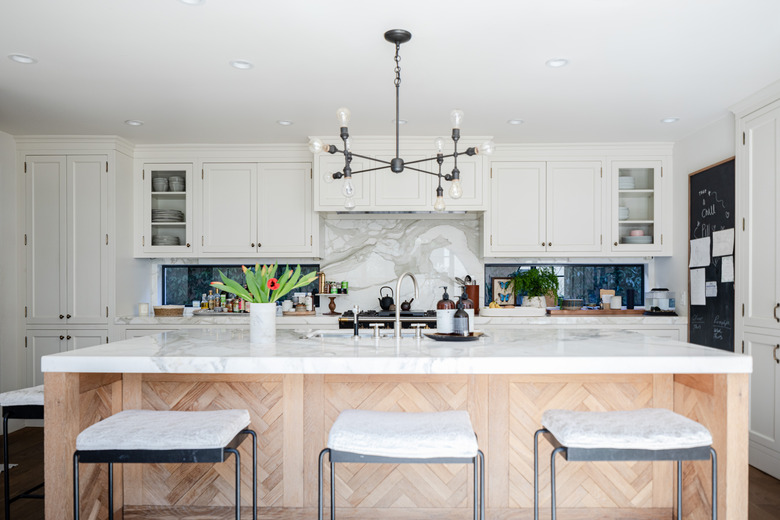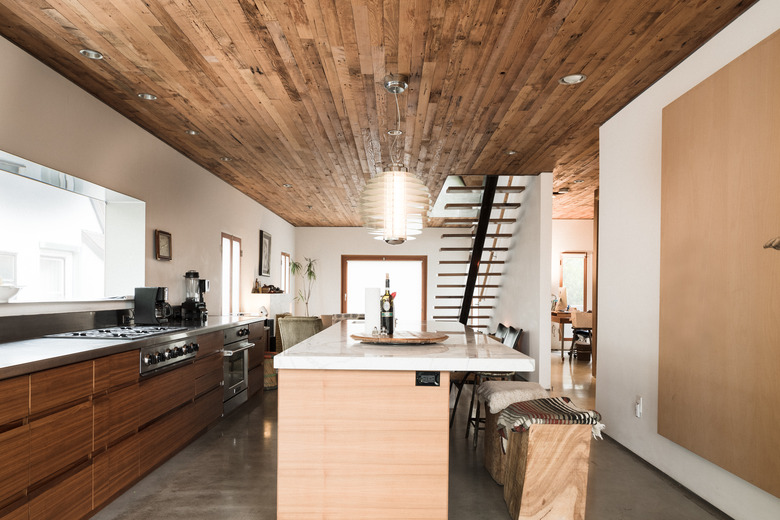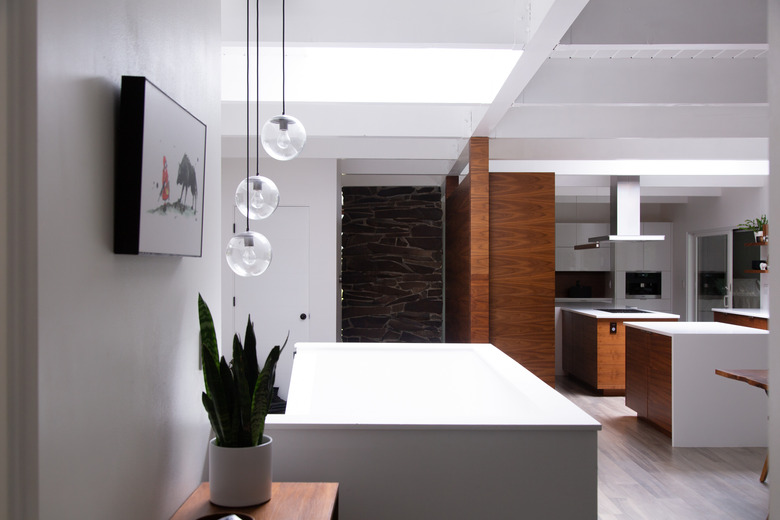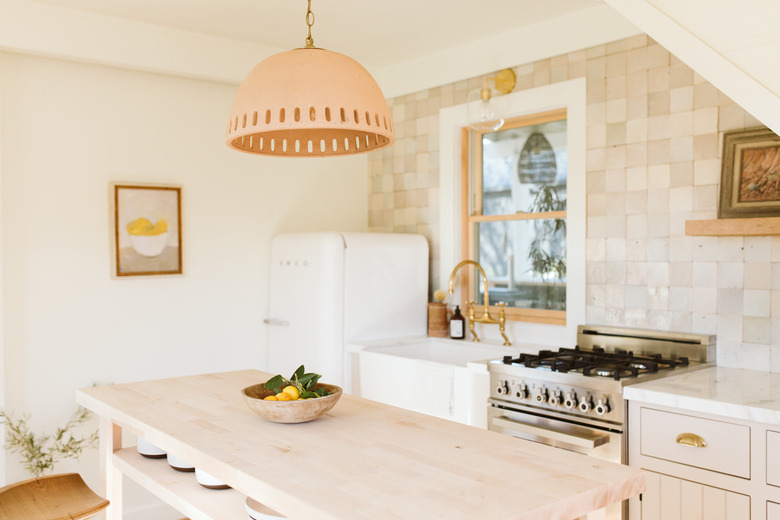How To Choose Kitchen Island Lighting
You've always wanted a kitchen island, and now you've got one. Unfortunately, you're now standing in the lighting aisle of your local home improvement store feeling completely overwhelmed by all the different ways you can illuminate it. Luckily, builders and interior designers have created lots of guidelines to help you narrow your choices and get your kitchen island lighting right.
These tips are an excellent way to get you started down the right path, but remember that there are no hard and fast rules. At the end of the day, it's more about what you like and what works in your kitchen. If you think your new kitchen island lighting looks good, it doesn't matter if it breaks all the rules.
Know Your Kitchen Island Purpose
Know Your Kitchen Island Purpose
Before you worry about how your light fixture is going to look, figure out what you want it to do. If, for example, you have a fairly small kitchen, you may want to get a ceiling-mount light that can serve as ambient, or general, lighting for the entire room and your kitchen island. Recessed ceiling lights also can function as ambient lighting and illuminate your kitchen island perfectly as long as your light layout ensures that one or two lights will fall above your island.
If your ambient lighting isn't quite enough for your island countertop, you'll need to install task lighting to make working at the island easier. Task lighting should focus light directly onto your work surface, making downward-facing pendant lights an excellent choice. If your ceiling is high, use hanging fixtures to get the light closer to you.
Knowing what you need will help you better determine which light fixtures can provide it and which ones will prove disappointing.
Kitchen Island Lighting Height
Kitchen Island Lighting Height
When deciding how high to hang your kitchen lighting, you can start at the bottom or the top. According to Better Homes & Gardens, hanging light fixtures should fall 12 to 20 inches below an 8-foot ceiling. If your ceiling is taller, add 3 inches for each additional foot of ceiling height.
Alternatively, you can measure from your kitchen island up. To provide adequate task lighting without glare, leave 30 to 36 inches of clearance between the top of your kitchen island and the bottom of your hanging light fixture. In a perfect world, your lights would fall perfectly between the ceiling and the countertop. In the real world, you may need to choose one of these measurements. Whichever measurement you use, it may need some tweaking.
The kitchen is the heart of the home, and some families spend quite a bit of time there. If your light fixture ends up hanging at eye level and potentially impeding the flow of conversation across the island, make adjustments. You can move chandeliers and single fixtures up a bit, opt for smaller minipendant lights or choose fixtures with glass shades and a more open feel. If using pendant lights, you can also stagger the height of the lights, raising some and lowering others to add visual interest and clear the air.
How Many Light Pendants and How Far Apart?
How Many Light Pendants and How Far Apart?
If you choose pendant fixtures for your kitchen island lighting, how many should you hang and how far apart? The answer? It depends. As a general rule, the folks at Del Mar Fans & Lighting suggest that the space between pendant lights should be the same as each pendant's width.
If you like math, however, you can take things a step further. To determine how wide the light pendant fixtures over your island should be, begin by measuring the length and width of your kitchen island in feet. Subtract 1 foot from the length and another foot from the width. Add the new width and depth together. This will tell you how many inches wide your pendant lighting fixtures can be.
To figure out how far apart to space the pendant lights, measure the length of your island in inches and subtract 12. Divide the resulting number by the ideal light width you calculated in the previous step. Divide this number by two to determine how many lights you need.
Kitchen Island Lighting: Fitting In or Standing Out
Kitchen Island Lighting: Fitting In or Standing Out
Your kitchen island isn't, well, an island. It is part of your entire kitchen and as such, it needs to work with the rest of the space. That doesn't mean your kitchen island lighting has to perfectly match your other light fixtures, but it does have to fit in with them in a way that makes sense.
To ensure that your kitchen island lighting works with the rest of the room, match it to something. You can choose a metal light fixture that matches your cabinet door pulls or kitchen faucet, for instance. Keep in mind the style of your kitchen as well. If your kitchen has a rustic or laid-back feel, don't install a fancy crystal chandelier over the island. For more modern kitchens, consider a single long but minimalist LED bar light above the island.
If you want your kitchen island lighting to blend in rather than stand out, choose light fixtures that match a large portion of the space, such as the cabinets or the countertops. You can also utilize glass fixtures to avoid adding new colors to the space or use fixtures that mimic the look of bare light bulbs. Ceiling mount lighting and recessed lights also tend to be more discreet and won't hang down in your line of sight.
Other Kitchen Island Lighting Considerations
Other Kitchen Island Lighting Considerations
Think about practical considerations as well as aesthetics when choosing kitchen island lighting. Drum lights and chandeliers sometimes feature fabric lamp shades. These can be hard to keep clean, however, especially if they'll sit near your stove where greasy dirt gathers.
Be careful with pendant lights that have open bottoms. These expose the light bulbs within, which may not concern you but could cause a glare for children who are helping in the kitchen. Choose fixtures that are enclosed on the bottom to hide the bulb or install the lights on a dimmer switch so you can adjust them as needed.
Light Bulbs Matter
Light Bulbs Matter
When lighting your kitchen island, the kind of light your fixtures will cast is just as important as how the fixture looks in your space. For task lighting, you'll ideally want a light bulb in the 2,700 to 3,500 kelvin range. These lights are close to neutral, producing a light that is more white than blue or yellow. You can, however, go a bit cooler if your kitchen has a very modern feel or a bit warmer if your kitchen decor leans that way.
It's always a good idea to consider LED bulbs as well. These bulbs last much longer than traditional incandescent bulbs and consume a lot less energy. They also stay cool, meaning your kitchen lighting won't add more heat to an already warm area of your home. Some LED lights are quite bright, making them an excellent choice if you want wall-mount fixtures above your island rather than fixtures that hang. The brightness will ensure that the light reaches your workspace adequately, even though it's farther away.
The Magic of the Dimmer Switch
The Magic of the Dimmer Switch
No matter what type of light you choose for your kitchen island, give serious thought to installing it with a dimmer switch. A dimmer switch lets you crank up the brightness on your island so you can see what you're doing when building that volcano for the school science fair and lets you turn it down during a romantic dinner for two.
With a dimmer, your kitchen island lighting can serve as task lighting when you need it and can even serve as ambient lighting on cloudy days where a little extra light is enough to fill the room. It can also serve as accent lighting, letting you turn off the other lights in the room and keep the focus on your island. A dimmed light can also serve as a night light when a midnight snack starts calling your name.
You can also add toe-kick lighting to your island. This type of accent lighting is installed at the bottom of the kitchen island and shines down onto the floor. When turned on, toe-kick lights almost create the illusion that the island is floating and calls attention to this key kitchen feature in a subtle but effective way. Toe-kick lighting also makes a great night light for late-night snacking.
Pendant Light Overload?
Pendant Light Overload?
While shopping for kitchen island lighting, you'll find an overwhelming number of pendant light fixtures from which to choose. You may also find that salespeople drift toward the pendant lights as soon as you utter the words "kitchen island." This happens because pendant lights are some of the most flexible and popular choices for islands. There are other choices, however, and they deserve more attention than the passing mention they often get.
You can opt to put a ceiling-mount light above your kitchen island, and these work especially well when the island is in the middle of the room. You can opt for a flush-mount light that clings to the ceiling or a short light that hangs only a few inches below it. These lights will cast a wide arc and provide more than adequate island lighting if they're bright enough. As an added bonus, you need not worry about them hanging down and creating a cluttered look. You can even choose a fixture with a light and a ceiling fan if you like to keep cool while you work.
Recessed lighting is another good option, especially in kitchens where a low ceiling makes other light fixtures seem overly large and intrusive. When installing them as task lighting over a kitchen island, choose recessed lights that are between 3 and 5 inches in diameter. Be aware that some recessed lights are designed to solve problems other lights can't. There are, for example, recessed lighting cans specifically designed for shallow ceilings that aren't very thick and for sloped ceilings where getting even lighting can be tricky.
References
- Better Homes & Gardens: Kitchen Pendant Lighting Tips
- Del Mar Fans & Lighting: Pendant Lighting Guide for Kitchen Islands, Dining Room Tables & Doors
- Forbes: 4 Types Of Kitchen Pendant Lights And How To Choose The Right One For Your Island
- 2Modern: Delicious Kitchen Island Lighting in 4 Simple Steps
- YLighting: How To Light A Kitchen Island
- Sebring: How to Choose the Right Kitchen Island Lights



